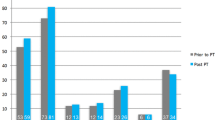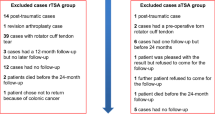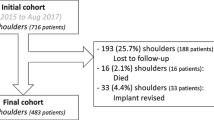Abstract
Introduction
Reverse shoulder arthroplasty shifts the rotational center of the shoulder joint caudally and medially to restore shoulder function in a rotator cuff deficient shoulder. Despite promising results in early- and mid-term follow-up, long-term loss in shoulder function has been described in the literature. A lack of exercise in elderly patients may be one reason for this loss in function. This study examines the functional benefits of physical therapy in the mid-term to long-term follow-up regarding the subjective and objective shoulder function.
Materials and methods
Twenty patients with a mean age of 73 years were included in this series. The study was performed as a single-center, prospective study. Initial indications for reverse shoulder arthroplasty were cuff tear arthropathy, failed anatomical shoulder arthroplasty, and fracture sequelae. The patients were clinically examined at a mean follow-up of 62 months using the Constant score (CS) and the DASH score for the operated and the non-operated shoulder. They were reevaluated using the same scores following a standardized physical therapy program of 6 weeks’ duration.
Results
The mean CS as well as the mean age- and gender-adjusted CS of the affected shoulder improved significantly from 53.5 points to 59.3 points, and 72.7–80.8%, respectively. The subcategories activities of daily living and range of motion of the CS improved significantly, whereas no significant improvement was observed for the subcategories pain and strength. Evaluating the contralateral shoulder, no significant change was observed for the age- and gender-adjusted CS and the CS as well as its subcategories. We found no significant difference in the CS comparing the different etiologies prior to physical therapy.
Discussion
Physical therapy plays an important role subsequent to reverse shoulder arthroplasty. It also has an effect in the mid-term to long-term follow-up regarding the range of motion as well as activities of daily living. However, physical therapy seems to have limited effect on the strength and the residual pain level.
Level of evidence
Level III.

Similar content being viewed by others
References
Grammont P, Trouillod P, Laffay JP, Deries X (1987) Etude et réalisation d’une nouvelle prothèse d’épaule. Rheumatologie 39:407–418
Grammont PM, Baulot E (1993) Delta shoulder prosthesis for rotator cuff rupture. Orthopedics 16:65–68
Sirveaux F, Favard L, Oudet D, Huquet D, Walch G, Molé D (2004) Grammont inverted total shoulder arthroplasty in the treatment of glenohumeral osteoarthritis with massive rupture of the cuff. Results of a multicentre study of 80 shoulders. J Bone Jt Surg Br 86:388–395
Naveed MA, Kitson J, Bunker TD (2011) The Delta III reverse shoulder replacement for cuff tear arthropathy: a single-centre study of 50 consecutive procedures. J Bone Jt Surg Br 93:57–61. https://doi.org/10.1302/0301-620X.93B1.24218
Cuff D (2008) Reverse shoulder arthroplasty for the treatment of rotator cuff deficiency. J Bone Jt Surg 90:1244. https://doi.org/10.2106/JBJS.G.00775
Werner CML, Steinmann PA, Gilbart M, Gerber C (2005) Treatment of painful pseudoparesis due to irreparable rotator cuff dysfunction with the Delta III reverse-ball-and-socket total shoulder prosthesis. J Bone Jt Surg Am 87:1476–1486. https://doi.org/10.2106/JBJS.D.02342
Flury MP, Frey P, Goldhahn J, Schwyzer H-K, Simmen BR (2011) Reverse shoulder arthroplasty as a salvage procedure for failed conventional shoulder replacement due to cuff failure—midterm results. Int Orthop 35:53–60. https://doi.org/10.1007/s00264-010-0990-z
Levy JC, Virani N, Pupello D, Frankle M (2007) Use of the reverse shoulder prosthesis for the treatment of failed hemiarthroplasty in patients with glenohumeral arthritis and rotator cuff deficiency. J Bone Jt Surg Br 89–B:189–195. https://doi.org/10.1302/0301-620X.89B2.18161
Boileau P, Watkinson D, Hatzidakis AM, Hovorka I (2006) Neer Award 2005: The Grammont reverse shoulder prosthesis: results in cuff tear arthritis, fracture sequelae, and revision arthroplasty. J Shoulder Elb Surg 15:527–540. https://doi.org/10.1016/j.jse.2006.01.003
Klein M, Juschka M, Hinkenjann B, Scherger B, Ostermann PAW (2008) Treatment of comminuted fractures of the proximal humerus in elderly patients with the Delta III reverse shoulder prosthesis. J Orthop Trauma 22:698–704. https://doi.org/10.1097/BOT.0b013e31818afe40
Kontakis G, Tosounidis T, Galanakis I, Megas P (2008) Prosthetic replacement for proximal humeral fractures. Injury 39:1345–1358. https://doi.org/10.1016/j.injury.2008.09.003
Merschin D, Stangl R (2015) Proximale Humerusfraktur im fortgeschrittenen Lebensalter. Unfallchirurg. https://doi.org/10.1007/s00113-015-0009-8
Kaisidis A, Pantos PG, Heger H, Bochlos D, Selimas S, Oikonomoulas V (2014) Reverse shoulder arthroplasty for the treatment of three and four part fractures of the proximal humerus in patients older than 75 years old. Acta Orthop Belg 80:99–105
Boileau P, Watkinson DJ, Hatzidakis AM, Balg F (2005) Grammont reverse prosthesis: design, rationale, and biomechanics. J Shoulder Elb Surg 14:147S–161S. https://doi.org/10.1016/j.jse.2004.10.006
Terrier A, Reist A, Merlini F, Farron A (2008) Simulated joint and muscle forces in reversed and anatomic shoulder prostheses. J Bone Jt Surg Br 90–B:751–756. https://doi.org/10.1302/0301-620X.90B6.19708
Guery J, Favard L, Sirveaux F, Oudet D, Mole D, Walch G (2006) Reverse total shoulder arthroplasty. Survivorship analysis of eighty replacements followed for five to ten years. J Bone Jt Surg Am 88:1742–1747. https://doi.org/10.2106/JBJS.E.00851
Brems JJ (1994) Rehabilitation following total shoulder arthroplasty. Clin Orthop Relat Res 307:70–85
Brown DD, Friedman RJ (1998) Postoperative rehabilitation following total shoulder arthroplasty. Orthop Clin N Am 29:535–547
Pokorný D, Sosna A, Jahoda D, Pech J, Simková M, Szekeresová M (2000) Physical therapy after shoulder arthroplasty. Acta Chir Orthop Traumatol Cech 67:280–290
Boardman ND, Cofield RH, Bengtson KA, Little R, Jones MC, Rowland CM (2001) Rehabilitation after total shoulder arthroplasty. J Arthroplast 16:483–486. https://doi.org/10.1054/arth.2001.23623
Wilcox RB, Arslanian LE, Millett P (2005) Rehabilitation following total shoulder arthroplasty. J Orthop Sport Phys Ther 35:821–836
Mulieri PJ, Holcomb JO, Dunning P, Pliner M, Bogle RK, Pupello D, Frankle MA (2010) Is a formal physical therapy program necessary after total shoulder arthroplasty for osteoarthritis? J Shoulder Elb Surg 19:570–579. https://doi.org/10.1016/j.jse.2009.07.012
Hudak PL, Amadio PC, Bombardier C (1996) Development of an upper extremity outcome measure: the DASH (disabilities of the arm, shoulder and hand) [corrected]. The Upper Extremity Collaborative Group (UECG). Am J Ind Med 29:602–608. https://doi.org/10.1002/(SICI)1097-0274(199606)29:6<602::AID-AJIM4>3.0.CO;2-L
Constant CR, Murley AH (1987) A clinical method of functional assessment of the shoulder. Clin Orthop Relat Res 214:160–164
Katolik LI, Romeo AA, Cole BJ, Verma NN, Hayden JK, Bach BR (2005) Normalization of the Constant score. J Shoulder Elb Surg 14:279–285. https://doi.org/10.1016/j.jse.2004.10.009
Baulot E, Chabernaud D, Grammont PM (1995) Results of Grammont’s inverted prosthesis in omarthritis associated with major cuff destruction. Apropos of 16 cases. Acta Orthop Belg 61(Suppl 1):112–119
Mulieri P, Dunning P, Klein S, Pupello D, Frankle M (2010) Reverse shoulder arthroplasty for the treatment of irreparable rotator cuff tear without glenohumeral arthritis. J Bone Jt Surg Am 92:2544–2556. https://doi.org/10.2106/JBJS.I.00912
Cazeneuve JF, Cristofari DJ (2011) Long term functional outcome following reverse shoulder arthroplasty in the elderly. Orthop Traumatol Surg Res 97:583–589. https://doi.org/10.1016/j.otsr.2011.03.025
Neer CS, Craig EV, Fukuda H (1983) Cuff-tear arthropathy. J Bone Jt Surg Am 65:1232–1244
de Toledo JM, Loss JF, Janssen TW, van der Scheer JW, Alta TD, Willems WJ, Veeger DH (2012) Kinematic evaluation of patients with total and reverse shoulder arthroplasty during rehabilitation exercises with different loads. Clin Biomech (Bristol Avon). https://doi.org/10.1016/j.clinbiomech.2012.04.009
Walker D, Matsuki K, Struk AM, Wright TW, Banks SA (2015) Scapulohumeral rhythm in shoulders with reverse shoulder arthroplasty. J Shoulder Elb Surg 24:1129–1134. https://doi.org/10.1016/j.jse.2014.11.043
Walker D, Wright TW, Banks S, Struk AM (2014) Electromyographic analysis of reverse total shoulder arthroplasties. J Shoulder Elb Surg 23:166–172. https://doi.org/10.1016/j.jse.2013.05.005
Ekstrom RA, Donatelli RA, Soderberg GL (2003) Surface electromyographic analysis of exercises for the trapezius and serratus anterior muscles. J Orthop Sports Phys Ther 33:247–258. https://doi.org/10.2519/jospt.2003.33.5.247
Ekstrom RA, Soderberg GL, Donatelli RA (2005) Normalization procedures using maximum voluntary isometric contractions for the serratus anterior and trapezius muscles during surface EMG analysis. J Electromyogr Kinesiol 15:418–428. https://doi.org/10.1016/j.jelekin.2004.09.006
Farina D, Madeleine P, Graven-Nielsen T, Merletti R, Arendt-Nielsen L (2002) Standardising surface electromyogram recordings for assessment of activity and fatigue in the human upper trapezius muscle. Eur J Appl Physiol 86:469–478. https://doi.org/10.1007/s00421-001-0574-0
Phadke V, Camargo P, Ludewig P (2009) Scapular and rotator cuff muscle activity during arm elevation: a review of normal function and alterations with shoulder impingement. Braz J Phys Ther 13:1–9. https://doi.org/10.1590/S1413-35552009005000012
Reinold MM, Wilk KE, Fleisig GS, Zheng N, Barrentine SW, Chmielewski T, Cody RC, Jameson GG, Andrews JR (2004) Electromyographic analysis of the rotator cuff and deltoid musculature during common shoulder external rotation exercises. J Orthop Sport Phys Ther 34:385–394. https://doi.org/10.2519/jospt.2004.34.7.385
Boudreau S, Boudreau ED, Higgins LD, Wilcox RB (2007) Rehabilitation following reverse total shoulder arthroplasty. J Orthop Sports Phys Ther 37:734–743. https://doi.org/10.2519/jospt.2007.2562
Funding
No funding was received.
Author information
Authors and Affiliations
Contributions
All authors were involved in treating and evaluating the patients. SU and SG were involved in data analysis and writing of the paper. SH and SP were involved in prove reading of the manuscript. All authors have reviewed and agree with the contents of the final draft of this article as submitted.
Corresponding author
Ethics declarations
Ethical standards
All procedures performed in studies involving human participants were in accordance with the ethical standards of the institutional and/or national research committee and with the 1964 Helsinki declaration and its later amendments or comparable ethical standards.
Conflict of interest
Stephan Uschok, Sebastian Herrmann, Stephan Pauly, Carsten Perka and Stefan Greiner declare that they have no conflict of interest.
Rights and permissions
About this article
Cite this article
Uschok, S., Herrmann, S., Pauly, S. et al. Reverse shoulder arthroplasty: the role of physical therapy on the clinical outcome in the mid-term to long-term follow-up. Arch Orthop Trauma Surg 138, 1347–1352 (2018). https://doi.org/10.1007/s00402-018-2977-y
Received:
Published:
Issue Date:
DOI: https://doi.org/10.1007/s00402-018-2977-y




